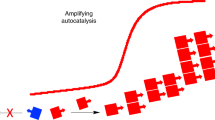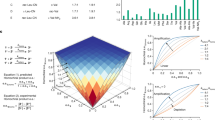Abstract
Biomolecular homochirality is universally observed in living systems but the molecular and evolutionary dynamics that led to its emergence are unknown. In fact, there are significant disadvantages in using chiral monomers for polymerization, which include enantiomeric cross-inhibition in racemic medium and under-utilization of available resources for self-replication in the primordial environment. Nevertheless, most investigations of homochirality in living systems assume that the individual primordial monomers were chiral prior to the formation of self-replicating polymer and therefore focus on identifying a symmetry-breaking mechanism that might choose one enantiomer over the other in a racemic medium. Within the premise that the extant biomolecules are products of molecular evolution, we ask a related but distinct question: why is an achiral monomer molecule disfavored? Here we identify an evolutionary advantage for molecular evolution to choose chiral over achiral monomers to construct primordial self-replicating polymers. We argue that when polymerization is constrained to proceed in only one direction along the template, as in DNA, evolution favors chiral monomers and homochiral polymers. This evolutionary advantage stems from the ability of a chiral monomer to bond with the template in only one orientation relative to the template monomer, along the direction of polymerization. An achiral monomer, on the other hand, offers more than one possible orientation for bonding with the template monomer, due to the presence of symmetry elements in its structure, which would lead to inhibition of polymerization. We show that the requirement of orientational specificity leads to monomer chirality, by using a known relationship between rotational and reflection symmetry elements, within the constraint that the resultant polymers are helical.




Similar content being viewed by others
References
Aoki T, Kaneko T, Maruyama N, Sumi A, Takahashi M, Sato T, Teraguchi M (2003) Helix-sense-selective polymerization of phenylacetylene having two hydroxy groups using a chiral catalytic system. J Am Chem Soc 125(21):6346–6347
Bada Jeffrey L, Miller Stanley L (1987) Racemization and the origin of optically active organic compounds in living organisms. Biosystems 20(1):21–26
Cotton FA (1971) Chemical applications of group theory. Wiley, Hoboken
Deming TJ, Novak BM (1992) Enantioselective polymerizations of achiral isocyanides. preparation of optically active helical polymers using chiral nickel catalysts. J Am Chem Soc 114(20):7926–7927
Eigen M, Schuster P (1977) A principle of natural self-organization. Naturwissenschaften 64(11):541–565
Engel MH, Macko S (1997) Isotopic evidence for extraterrestrial non-racemic amino acids in the murchison meteorite. Nature 389(6648):265–268
Engelhart AE, Hud NV (2010) Primitive genetic polymers. Cold Spring Harb Perspect Biol 2(12):a002196
Goldanskii V, Avetisov V, Kuzmin V (1986) Chiral purity of nucleotides as a necessary condition of complementarity. FEBS Lett 207(1):181–183
Green R, Szostak JW (1992) Selection of a ribozyme that functions as a superior template in a self-copying reaction. Science 258(5090):1910–1915
Huang H, Yuan Y, Deng J (2015) Helix-sense-selective precipitation polymerization of achiral monomer for preparing optically active helical polymer particles. Macromolecules 48(11):3406–3413
Hud NV, Cafferty BJ, Krishnamurthy R, Williams LD (2013) The origin of RNA and my grandfather’s axe. Chem Biol 20(4):466–474
Joyce G, Visser G, van Boeckel C, van Boom J, Orgel L, van Westrenen J (1983) Chiral selection in poly (C)-directed synthesis of oligo (G). Nature 310(5978):602–604
Joyce GF, Schwartz AW, Miller SL, Orgel LE (1987) The case for an ancestral genetic system involving simple analogues of the nucleotides. Proc Natl Acad Sci USA 84(13):4398–4402
Karri P, Punna V, Kim K, Krishnamurthy R (2013) Base pairing properties of a structural isomer of glycerol nucleic acid. Angew Chem Int Ed 52(22):5840–5844
Lee DH, Granja JR, Martinez JA, Severin K, Ghadiri MR (1996) A self-replicating peptide. Nature 382(6591):525–528
Lee DH, Severin K, Yokobayashi Y, Ghadiri MR (1997) Emergence of symbiosis in peptide self-replication through a hypercyclic network. Nature 390(6660):591–594
Leslie EO (2004) Prebiotic chemistry and the origin of the RNA world. Crit Rev Biochem Mol Biol 39(2):99–123
Menchise V, De Simone G, Tedeschi T, Corradini R, Sforza S, Marchelli R, Capasso D, Saviano M, Pedone C (2003) Insights into peptide nucleic acid (PNA) structural features: The crystal structure of a d-lysine-based chiral PNA–DNA duplex. Proc Natl Acad Sci USA 100(21):12021–12026
Morozov AV, Kortemme T, Tsemekhman K, Baker D (2004) Close agreement between the orientation dependence of hydrogen bonds observed in protein structures and quantum mechanical calculations. Proc Natl Acad Sci USA 101(18):6946–6951
Nielsen PE, Egholm M, Berg RH, Buchardt O (1991) Sequence-selective recognition of DNA by strand displacement with a thymine-substituted polyamide. Science 254(5037):1497–1500
Nielsen PE, Haaima G, Lohse A, Buchardt O (1996) Peptide nucleic acids (PNAs) containing thymine monomers derived from chiral amino acids: hybridization and solubility properties of D-lysine PNA. Angew Chem Int Ed Engl 35:1939–1942
Podlech J (2001) Origin of organic molecules and biomolecular homochirality. Cell Mol Life Sci CMLS 58(1):44–60
Root-Bernstein R (2007) Simultaneous origin of homochirality, the genetic code and its directionality. BioEssays 29(7):689–698
Saghatelian A, Yokobayashi Y, Soltani K, Ghadiri MR (2001) A chiroselective peptide replicator. Nature 409(6822):797–801
Schmidt JG, Nielsen PE, Orgel LE (1997) Enantiomeric cross-inhibition in the synthesis of oligonucleotides on a nonchiral template. J Am Chem Soc 119(6):1494–1495
Soai K, Shibata T, Morioka H, Choji K (1995) Asymmetric autocatalysis and amplification of enantiomeric excess of a chiral molecule. Nature 378:767–768
Subramanian H, Gatenby RA (2018) Evolutionary advantage of directional symmetry breaking in self-replicating polymers. J Theoret Biol 446:128–136
Tian G, Lu Y, Novak BM (2004) Helix-sense selective polymerization of carbodiimides: building permanently optically active polymers from achiral monomers. J Am Chem Soc 126(13):4082–4083
Acknowledgements
Support for this work was provided by the Moffitt Physical Science and Oncology Network (PS-ON) NIH grant, U54CA193489. We thank Gerald Joyce, Antonio Lazcano, Addy Pross, John Cleveland, Joel Brown, Christopher Whelan, and Robert Gillies for useful comments. HS thanks Artem Kaznatcheev, IMO faculty, and post-doctoral associates for helpful discussions.
Author information
Authors and Affiliations
Corresponding author
Ethics declarations
The authors declare no competing financial interests.
Rights and permissions
About this article
Cite this article
Subramanian, H., Gatenby, R.A. Chiral Monomers Ensure Orientational Specificity of Monomer Binding During Polymer Self-Replication. J Mol Evol 86, 255–263 (2018). https://doi.org/10.1007/s00239-018-9845-9
Received:
Accepted:
Published:
Issue Date:
DOI: https://doi.org/10.1007/s00239-018-9845-9




